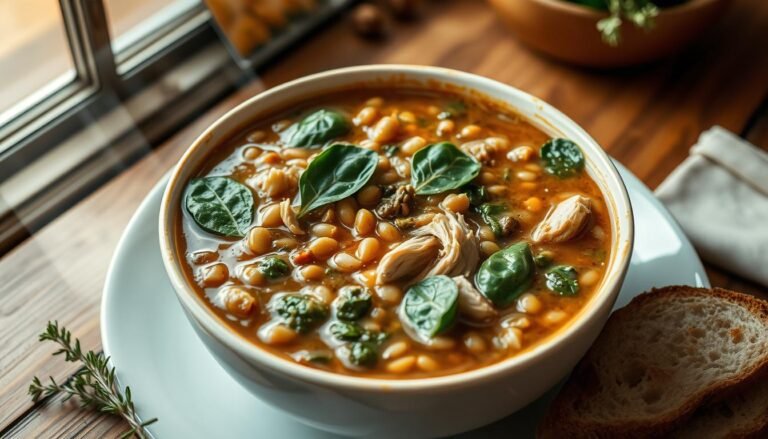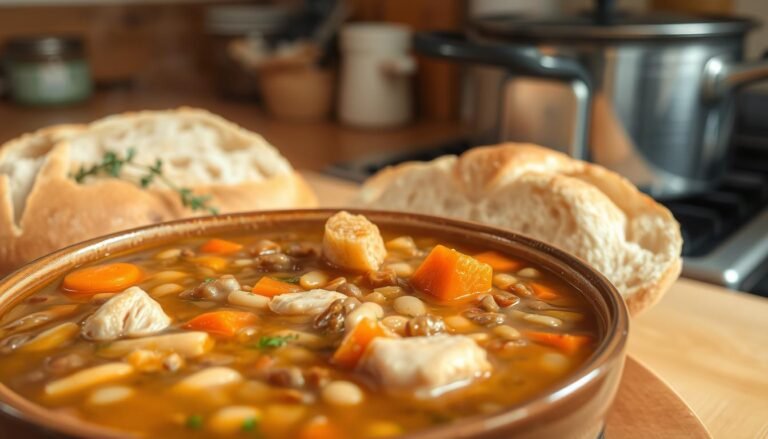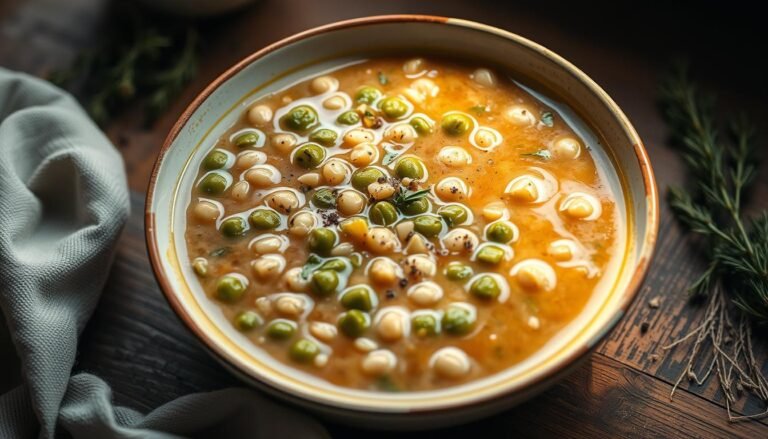Indulge in a delicious and nutritious meal with our Coconut & Red Lentil Curry, ready in just 30 minutes with only 8 ingredients!
This vegan curry is not only a treat for your taste buds but also packed with nutrients, making it a perfect dinner option for a cozy night in.
Our lentil curry recipe is easy to prepare, flavorful, and a great way to incorporate plant-based meals into your diet.
Key Takeaways
- Quick and easy preparation
- Nutritious and filling meal
- Perfect for a cozy dinner
- Vegan-friendly ingredients
- Ready in just 30 minutes
The Rich History of Lentil Curry
Indian lentil curry, known for its flavorful and nutritious profile, has been a cornerstone of South Asian cuisine for centuries. This dish has not only sustained local populations but has also gained popularity worldwide due to its versatility and health benefits.
Origins in South Asian Cuisine
Lentil curry, or “dal” as it’s commonly known in India, has its roots deeply embedded in the culinary practices of South Asia. The use of lentils, a rich source of protein, dates back to ancient times when they were considered a staple food. The preparation methods varied across regions, with each community adding its unique twist to the recipe. Spices played a crucial role in defining the flavor profile, with ingredients like turmeric, cumin, and coriander being fundamental to the curry’s base.
Evolution and Global Popularity
As global cuisines evolved, lentil curry transitioned from a local Indian dish to a global phenomenon. Its adaptability to various tastes and dietary preferences made it a favorite among diverse populations. The table below highlights some of the variations of lentil curry found around the world.
| Region | Variation | Key Ingredients |
|---|---|---|
| South India | Sambar | Toor dal, tamarind, and a blend of spices |
| North India | Dal Makhani | Black lentils, kidney beans, and a creamy tomato base |
| Sri Lanka | Parippu | Red lentils, coconut milk, and a hint of cinnamon |
This evolution not only showcases the dish’s versatility but also its ability to be embraced by different cultures, making lentil curry a truly global culinary delight.
Health Benefits of Lentils in Your Diet
Lentils are a nutritional powerhouse, offering a multitude of health benefits when consumed as part of a balanced diet. They are an excellent source of plant-based protein, fiber, iron, and other essential nutrients, making them a great addition to vegan curries and lentil curries.
Nutritional Profile of Lentils
Lentils are rich in vitamins and minerals, including folate, manganese, and copper. They are also low in fat and high in antioxidants, which can help protect against chronic diseases. The nutritional profile of lentils makes them an excellent choice for a healthy diet.
Plant-Based Protein Powerhouse
Lentils are an outstanding source of plant-based protein, making them ideal for vegans and vegetarians. They contain about 18 grams of protein per cup, which is roughly 35% of the daily recommended intake. Incorporating lentils into your meals, such as in a vegan curry, can significantly boost your protein consumption.
Fiber and Digestive Health
The high fiber content in lentils supports digestive health by promoting regular bowel movements and preventing constipation. A diet rich in fiber can also help lower cholesterol levels and control blood sugar levels. Lentil curry is a delicious way to increase your fiber intake.
Incorporating lentils into your diet can have numerous health benefits, from providing essential nutrients to supporting heart health and digestive wellbeing. Whether you’re making a lentil curry or adding lentils to other dishes, you’re making a positive choice for your health.
Understanding Different Types of Lentils
The world of lentils is diverse, with various types offering unique characteristics that can elevate your spicy lentil dish. Lentils are a staple ingredient in many cuisines, particularly in South Asian cooking, where they are used to make a variety of curries and dals. Understanding the different types of lentils and their uses can help you choose the best variety for your lentil curry recipe.

Red Lentils: Quick-Cooking Option
Red lentils are known for their bright orange-red color and quick cooking time. They break down easily during cooking, making them ideal for soups and curries where a smooth texture is desired. Red lentils are a great choice for a spicy lentil dish as they absorb flavors well and cook rapidly, usually within 20-25 minutes.
Brown and Green Lentils: Hearty Alternatives
Brown and green lentils are more robust than red lentils and hold their shape better during cooking. They have a slightly earthy flavor and are often used in salads, stews, and casseroles. For a lentil curry, brown or green lentils can be used to create a heartier, more textured dish. They take a bit longer to cook than red lentils, typically requiring 30-40 minutes.
Black Lentils: The Caviar of Legumes
Black lentils, also known as beluga lentils, are small, shiny, and dark. They have a rich, earthy flavor and a firm texture that makes them a favorite in many recipes. Black lentils are considered the “caviar of legumes” due to their luxurious texture and appearance. They take the longest to cook among the lentil varieties, often requiring 40-45 minutes, but their unique texture and flavor make them well worth the wait.
Yellow Lentils: Mild and Versatile
Yellow lentils are similar to red lentils but have a slightly different flavor profile. They are mild, slightly sweet, and cook relatively quickly. Yellow lentils are versatile and can be used in a variety of dishes, from curries to dals. They are a good option for those looking for a milder lentil curry that still packs a nutritional punch.
For more information on the different types of lentils and their uses, you can visit Country Life Foods, which provides an in-depth exploration of various lentil types.
Essential Spices for an Authentic Lentil Curry
The secret to an authentic Indian lentil curry lies in its spice blend. A well-balanced mix of spices can elevate this vegan dish into a culinary masterpiece. In this section, we’ll explore the essential spices that make lentil curry not only delicious but also authentic.
The Foundation: Cumin, Coriander, and Turmeric
The foundation of any good lentil curry starts with cumin, coriander, and turmeric. These spices not only add depth but also provide a warm, earthy flavor. Cumin brings a earthy warmth, while coriander adds a slightly sweet and citrusy note. Turmeric, known for its vibrant yellow color, contributes a subtle bitterness that balances the other spices.
Using these spices in their whole and ground forms can significantly enhance the flavor. For instance, toasting whole cumin and coriander seeds before grinding them can release their essential oils, intensifying their flavors.
Heat Elements: Chili, Ginger, and Black Pepper
For those who enjoy a bit of heat in their lentil curry, chili peppers are a must. They add a spicy kick that can be adjusted according to taste. Ginger adds another layer of heat along with its digestive benefits. Black pepper, often overlooked, plays a crucial role in enhancing the overall flavor and aiding digestion.
The combination of these heat elements not only adds depth but also helps in creating a balanced flavor profile. Adjusting the quantity of chili peppers allows you to tailor the heat level to your preference.
Aromatic Enhancers: Cardamom, Cinnamon, and Cloves
Cardamom, cinnamon, and cloves are the aromatic enhancers that give lentil curry its distinct aroma. These spices are typically added at the beginning of the cooking process to allow their flavors to infuse into the dish. They add a complexity and warmth that is characteristic of Indian lentil curry.
| Spice | Flavor Profile | Usage |
|---|---|---|
| Cumin | Earthy, Warm | Whole or Ground |
| Coriander | Sweet, Citrusy | Whole or Ground |
| Turmeric | Subtly Bitter, Earthy | Ground |
| Chili Peppers | Spicy | Whole or Ground |
| Ginger | Spicy, Warm | Fresh or Ground |
By understanding and utilizing these essential spices, you can create a lentil curry that is not only vegan-friendly but also rich in flavor and aroma. Experimenting with different proportions of these spices can help you find your perfect blend.
Preparing Your Kitchen for Lentil Curry Success
A well-prepared kitchen is essential for cooking a great lentil curry. Having the right equipment and ingredients ready can make the cooking process smoother and more enjoyable.
Essential Equipment
To make a delicious lentil curry, you’ll need a few key pieces of equipment. A large pot is necessary for cooking the lentils and curry sauce. A blender or food processor can be useful for pureeing some or all of the curry for a thicker consistency. Basic cooking utensils like a wooden spoon and a whisk are also essential.
Ingredient Preparation Tips
Preparing your ingredients before starting to cook can significantly streamline the process. Begin by rinsing your lentils thoroughly to remove any debris. Chop your onions, garlic, and ginger as required by your recipe, and have your spices measured out. For a spicy lentil dish, consider having your chili peppers or chili powder ready.
By having everything ready to go, you’ll be able to focus on the cooking process, ensuring your lentil curry turns out flavorful and satisfying.
The Ultimate Lentil Curry Recipe
Discover the secret to a hearty and fragrant vegan curry with our lentil curry recipe. This dish is not only delicious but also packed with nutrients, making it a perfect meal for any day of the week.
Ingredients List
To make our ultimate lentil curry, you will need the following ingredients:
- 1 cup red lentils, rinsed and drained
- 2 medium onions, chopped
- 3 cloves garlic, minced
- 1-inch piece of ginger, grated
- 2 tbsp curry powder
- 1 can coconut milk
- 2 cups vegetable broth
- Salt and pepper to taste
- Fresh cilantro for garnish
| Ingredient | Quantity |
|---|---|
| Red Lentils | 1 cup |
| Onions | 2 medium |
| Garlic | 3 cloves |
| Ginger | 1-inch piece |
| Curry Powder | 2 tbsp |
| Coconut Milk | 1 can |
| Vegetable Broth | 2 cups |
Step-by-Step Cooking Instructions
Follow these steps to create your lentil curry:
- In a large pan, sauté the onions, garlic, and ginger until softened.
- Add the curry powder and cook for another minute, stirring constantly.
- Add the red lentils, vegetable broth, and coconut milk. Bring to a boil.
- Reduce the heat and let simmer until the lentils are tender.
- Season with salt and pepper to taste.
- Garnish with fresh cilantro before serving.

Adjusting Consistency and Flavor
The beauty of lentil curry lies in its versatility. You can adjust the consistency by adding more vegetable broth for a thinner curry or simmering it longer for a thicker consistency. For an extra burst of flavor, consider adding a squeeze of fresh lime juice or a sprinkle of your favorite spices.
By following this recipe, you’ll have a delicious and nutritious vegan curry that’s sure to become a staple in your kitchen.
Regional Variations of Lentil Curry
From south to north, lentil curry adapts to local flavors, creating a rich culinary mosaic. This diversity is a testament to the dish’s versatility and its ability to incorporate various regional ingredients and cooking techniques.
South Indian Dal Variations
South Indian cuisine is known for its comforting dal preparations. Dal is a staple in South Indian households, often made with red or yellow lentils and seasoned with ingredients like curry leaves and tamarind. The use of coconut and a variety of local spices gives these dals a distinct flavor profile that is both comforting and aromatic.
North Indian Lentil Preparations
North Indian lentil preparations, on the other hand, tend to be heartier and often include a mix of lentils and other ingredients like vegetables or meat. Dal Makhani, a popular Punjabi dish, is made with black lentils and kidney beans in a creamy tomato-based sauce. This variation showcases the rich and diverse nature of North Indian lentil curries.
Sri Lankan Lentil Curry Style
Sri Lankan lentil curry is known for its bold flavors, thanks to the use of a variety of spices, including cinnamon, cardamom, and cloves. The addition of coconut milk gives the curry a creamy texture, while ingredients like curry leaves and pandan leaves add depth to the flavor. Sri Lankan lentil curry is a delicious example of how this dish can be adapted to local tastes and ingredients.
The regional variations of lentil curry not only reflect the diversity of Indian and Sri Lankan cuisine but also highlight the dish’s adaptability. Whether it’s a simple dal from the south or a rich, creamy curry from the north, lentil curry remains a beloved dish across the region.
Australian Twist on Traditional Lentil Curry
The Australian palate has embraced lentil curry, incorporating local ingredients for a fresh take. This fusion not only enhances the flavor but also makes the dish more relatable to the Australian audience. As we explore this adaptation, it’s clear that the versatility of lentil curry is one of its strongest attributes.
Incorporating Local Australian Ingredients
Australian cuisine is known for its diverse and vibrant food culture, often incorporating native ingredients like kakadu plum, lemon myrtle, and Davidson’s plum into traditional recipes. When it comes to lentil curry, these ingredients can add a unique twist. For instance, using kakadu plum can introduce a burst of vitamin C and flavor, while lemon myrtle can provide a citrusy note that complements the spices in the curry.
Native ingredients not only add a local flavor but also enhance the nutritional profile of the dish. For example, incorporating bush tomatoes can add depth and a slightly sweet flavor, making the lentil curry more complex and interesting.
Adapting to Australian Tastes and Preferences
Australians tend to prefer milder flavors, which can be achieved by adjusting the amount of chili or using alternative spices that add flavor without the heat. Additionally, there’s a growing trend towards vegan and gluten-free options, making lentil curry an ideal choice. By using coconut milk or almond milk, the curry can be made creamier and more palatable to a wider audience.
“The adaptability of lentil curry to local tastes is a testament to its global appeal and the creativity of Australian chefs.”
Popular Lentil Dishes in Australian Cuisine
In Australia, lentil curry is often served in cafes and restaurants as a vegan or vegetarian option. It’s commonly paired with rice or flatbread and can be found in various regional adaptations. The popularity of lentil curry in Australian cuisine is a reflection of the country’s multicultural influences and its embrace of international flavors.
Creating the Perfect Vegan Curry Base
Creating a rich and flavorful vegan curry starts with choosing the right base. The base of a curry is its foundation, determining its overall flavor profile and texture. In vegan curries, two popular options stand out: coconut milk and tomato-based curries.
Coconut Milk vs. Tomato Base
Coconut milk and tomato-based curries offer distinct experiences. Coconut milk adds a rich, creamy texture, ideal for those seeking a luxurious feel in their curry. On the other hand, tomato-based curries provide a tangy, slightly acidic flavor that can be very refreshing. The choice between the two often comes down to personal preference and the type of dish being prepared.
Enhancing Flavor Without Animal Products
Enhancing the flavor of vegan curries without animal products requires creativity. Using a variety of spices, herbs, and other plant-based ingredients can significantly boost the flavor. For instance, incorporating nutritional yeast can add a cheesy, nutty flavor, while smoked paprika can introduce a smoky depth. Experimenting with different combinations can lead to a rich and satisfying flavor profile.
Achieving Rich Texture in Plant-Based Curries
Achieving a rich texture in plant-based curries can be accomplished in several ways. Besides using coconut milk, other options include cashew cream, blended vegetables, or simply reducing the curry sauce to concentrate the flavors. Cashew cream, made by blending soaked cashews with water, can add a silky smoothness. Meanwhile, blending cooked vegetables into the curry can enhance its body without adding dairy.
By carefully selecting the base and employing various techniques to enhance flavor and texture, anyone can create a delicious and satisfying vegan curry. Whether you’re making a spicy lentil dish or a mild vegetable curry, the principles remain the same: creativity and experimentation are key.
Serving Suggestions and Accompaniments
To elevate your lentil curry experience, consider these serving suggestions. Lentil curry, a staple in many cuisines, particularly in Indian and Sri Lankan cooking, is often served with a variety of accompaniments that enhance its flavor and texture.
Traditional Rice Pairings
Rice is a classic accompaniment to lentil curry, with options like basmati, jasmine, or plain white rice. The fluffy texture of rice helps to soak up the flavorful curry sauce, making each bite a delightful experience. For a more authentic touch, try pairing your lentil curry with jeera rice, which is flavored with cumin seeds.
Bread Options: Naan, Roti, and Beyond
Bread is another popular choice to enjoy with lentil curry. Naan, with its soft, slightly leavened texture, is perfect for dipping into the curry. Roti, a simpler, unleavened flatbread, is another traditional option that pairs well. For a variation, consider trying garlic naan or whole wheat roti for added flavor and nutrition.
Complementary Side Dishes
To make your meal more balanced, consider adding side dishes that complement the flavors of your lentil curry. A simple salad or sautéed vegetables can provide a refreshing contrast. For a more traditional approach, raita (a yogurt side dish with cucumber and cumin) can help cool down the palate. Other options include pickles or papadum for added texture and flavor.
By incorporating these serving suggestions and accompaniments, you can turn a simple lentil curry into a memorable and satisfying meal. Experiment with different combinations to find your favorite way to enjoy this versatile dish.
Mastering Lentil Curry Techniques
Mastering lentil curry is about more than just following a recipe; it’s about technique. To create a truly exceptional spicy lentil dish, one must understand the nuances that elevate it from good to great.
The Art of Tempering Spices
Tempering spices, or “tadka,” is a fundamental technique in Indian cooking that adds depth and complexity to your lentil curry. It involves heating spices in oil or ghee to release their essential oils and intensify their flavors. The key is to temper the spices at the right temperature to avoid burning them, which can make your curry bitter.
To master the art of tempering, start with whole spices like cumin seeds, mustard seeds, and coriander seeds. As they begin to sizzle, add aromatics like onions, garlic, and ginger to create a rich, flavorful base for your curry.
Achieving the Perfect Lentil Texture
Cooking lentils to the perfect texture is crucial for a satisfying lentil curry. Overcooking can result in mushy, unappetizing lentils, while undercooking leaves them hard and unpleasant to eat. The ideal texture is tender but still retains some firmness.
To achieve this, monitor the cooking time closely and adjust based on the type of lentils you’re using. Red lentils, for instance, cook much faster than green or brown lentils.
Balancing Flavors in Your Curry
Balancing flavors is the final step in creating a harmonious spicy lentil dish. This involves adjusting the levels of salt, acidity, sweetness, and heat to create a balanced taste experience.
Taste your curry regularly as you cook and adjust the seasoning accordingly. A squeeze of fresh lemon juice can add brightness, while a sprinkle of salt can enhance the overall flavor.
Storing and Meal Prepping Your Spicy Lentil Dish
To make the most of your lentil curry, understanding how to store it is crucial. Proper storage not only maintains the flavor and texture but also ensures the dish remains safe to eat. Whether you’re meal prepping for the week or saving leftovers, here are some guidelines to follow.
Refrigeration Guidelines
Lentil curry can be safely stored in the refrigerator for up to 5 days. It’s essential to cool the curry to room temperature before transferring it to an airtight container. This helps prevent bacterial growth and keeps the curry fresh. When you’re ready to eat it, simply reheat and serve.
Freezing Methods for Batch Cooking
For longer storage, lentil curry can be frozen for up to 3 months. Use airtight, freezer-safe containers or freezer bags to prevent freezer burn. When freezing, it’s a good idea to portion the curry into meal-sized amounts. This makes reheating easier and more convenient. As Mark Bittman, a renowned food expert, once said, “Freezing is a great way to preserve food without losing much of its nutritional value.”
Reheating Techniques to Preserve Flavor
When reheating lentil curry, do so gently over low heat to preserve the flavors and texture. You can reheat it on the stovetop or in the microwave. Adding a splash of water or coconut milk can help restore the curry’s original consistency if it has thickened during storage. “The key to a great reheated curry is gentle heat,” notes a culinary expert. Always check that the curry is heated through to a safe temperature before serving.
Conclusion: Embracing the Versatility of Lentil Curry
Lentil curry is a versatile dish that can be adapted to various tastes and dietary preferences, making it a staple in many cuisines, including Indian lentil curry. The spicy lentil dish can be adjusted to suit different palates, from mildly flavored to extremely spicy.
Throughout this article, we’ve explored the rich history, health benefits, and various types of lentils, as well as essential spices and techniques for preparing an authentic Indian lentil curry. We’ve also discussed regional variations and how to adapt lentil curry to Australian tastes.
With its numerous variations and adaptability, lentil curry is a dish that encourages experimentation and creativity in the kitchen. Whether you’re a seasoned chef or a beginner, the spicy lentil dish is sure to become a favorite in your culinary repertoire.





